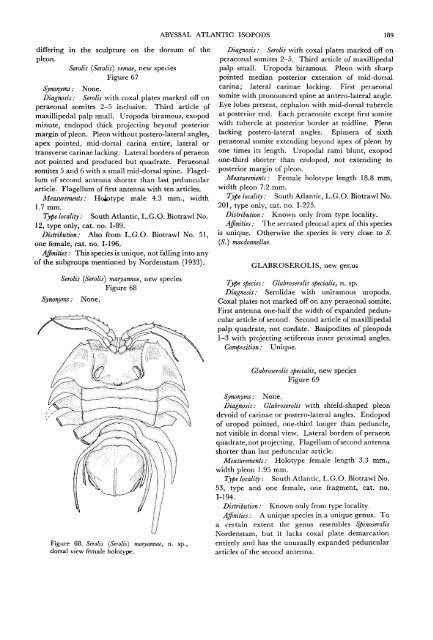The Isopods of Abyssal Depths in the Atlantic Ocean
The Isopods of Abyssal Depths in the Atlantic Ocean
The Isopods of Abyssal Depths in the Atlantic Ocean
Create successful ePaper yourself
Turn your PDF publications into a flip-book with our unique Google optimized e-Paper software.
differ<strong>in</strong>g <strong>in</strong> <strong>the</strong> sculpture on <strong>the</strong> dorsum <strong>of</strong> <strong>the</strong><br />
pleon.<br />
Serolis (Serolis) vemae, new species<br />
Figure 67<br />
Synonyms: None.<br />
Diagnosis: Serolis with coxal plates marked <strong>of</strong>f on<br />
peraeonal somites 2-5 <strong>in</strong>clusive. Third article <strong>of</strong><br />
maxillipedal palp small. Uropoda biramous, exopod<br />
m<strong>in</strong>ute, endopod thick project<strong>in</strong>g beyond posterior<br />
marg<strong>in</strong> <strong>of</strong> pleon. Pleon without postero-lateral angles,<br />
apex po<strong>in</strong>ted, mid-dorsal car<strong>in</strong>a entire, lateral or<br />
transverse car<strong>in</strong>ae lack<strong>in</strong>g. Lateral borders <strong>of</strong> peraeon<br />
not po<strong>in</strong>ted and produced but quadrate. Peraeonal<br />
somites 5 and 6 with a small mid-dorsal sp<strong>in</strong>e. Flagellum<br />
<strong>of</strong> second antenna shorter than last peduncular<br />
article. Flagellum <strong>of</strong> first antenna with ten articles.<br />
Measurements: Hoiatype male 4.3 mm., width<br />
1.7 mm.<br />
Type locality: South <strong>Atlantic</strong>, L.G.O. Biotrawl No.<br />
12, type only, cat. no. 1-89.<br />
Distribution: Also from L.G.O. Biotrawl No. 51,<br />
one female, cat. no. 1-196.<br />
Aff<strong>in</strong>ities: This species is unique, not fall<strong>in</strong>g <strong>in</strong>to any<br />
<strong>of</strong> <strong>the</strong> subgroups mentioned by Nordenstam (1933).<br />
Serolis (Serolis) maryannae, new species<br />
Figure 68<br />
Synonyms: None.<br />
Figure 68. Serolis (Serolis) maryannae, n. sp..<br />
dorsal view female holotype.<br />
ABYSSAL ATLANTIC ISOPODS 189<br />
Diagnosis: Serolis with coxal plates marked <strong>of</strong>f on<br />
peraeonal somites 2-5. Third article <strong>of</strong> maxillipedal<br />
palp small. Uropoda biramous. Pleon with sharp<br />
po<strong>in</strong>ted median posterior extension <strong>of</strong> mid-dorsal<br />
car<strong>in</strong>a; lateral car<strong>in</strong>ae lack<strong>in</strong>g. First peraeonal<br />
somite with pronounced sp<strong>in</strong>e at antero-lateral angle.<br />
Eye lobes present, cephalon with mid-dorsal tubercle<br />
at posterior end. Each peraeonite except first somite<br />
with tubercle at posterior border at midl<strong>in</strong>e. Pleon<br />
lack<strong>in</strong>g postero-lateral angles. Epimera <strong>of</strong> sixth<br />
peraeonal somite extend<strong>in</strong>g beyond apex <strong>of</strong> pleon by<br />
one times its length. Uropodal rami blunt, exopod<br />
one-third shorter than endopod, not extend<strong>in</strong>g to<br />
posterior marg<strong>in</strong> <strong>of</strong> pleon.<br />
Measurements: Female holotype length 18.8 mm,<br />
width pleon 7.2 mm.<br />
Type locality: South <strong>Atlantic</strong>, L.G.O. Biotrawl No.<br />
201, type only, cat. no. 1-225.<br />
Distribution: Known only from type locality.<br />
Aff<strong>in</strong>ities: <strong>The</strong> serrated pleonal apex <strong>of</strong> this species<br />
is unique. O<strong>the</strong>rwise <strong>the</strong> species is very close to S.<br />
(S.) macdonnellae.<br />
GLABROSEROLIS, new genus<br />
Type species: Glabroserolis specialis, n. sp.<br />
Diagnosis: Serolidae with uniramous uropoda.<br />
Coxal plates not marked <strong>of</strong>f on any peraeonal somite.<br />
First antenna one-half <strong>the</strong> width <strong>of</strong> expanded peduncular<br />
article <strong>of</strong> second. Second article <strong>of</strong> maxillipedal<br />
palp quadrate, not cordate. Basipodites <strong>of</strong> pleopods<br />
1-3 with project<strong>in</strong>g setiferous <strong>in</strong>ner proximal angles.<br />
Composition: Unique.<br />
Glabroserolis specialis, new species<br />
Figure 69<br />
Synonyms: None.<br />
Diagnosis: Glabroserolis with shield-shaped pleon<br />
devoid <strong>of</strong> car<strong>in</strong>ae or postero-lateral angles. Endopod<br />
<strong>of</strong> uropod po<strong>in</strong>ted, one-third longer than peduncle,<br />
not visible <strong>in</strong> dorsal view. Lateral borders <strong>of</strong> peraeon<br />
quadrate, not project<strong>in</strong>g. Flagellum <strong>of</strong> second antenna<br />
shorter than last peduncular article.<br />
Measurements: Holotype female length 3.3 mm.,<br />
width pleon 1.95 mm.<br />
Type locality: South <strong>Atlantic</strong>, L.G.O. Biotrawl No.<br />
53, type and one female, one fragment, cat. no.<br />
1-194.<br />
Distribution: Known only from type locality.<br />
Aff<strong>in</strong>ities: A unique species <strong>in</strong> a unique genus. To<br />
a certa<strong>in</strong> extent <strong>the</strong> genus resembles Sp<strong>in</strong>oserolis<br />
Nordenstam, but it lacks coxal plate demarcation<br />
entirely and has <strong>the</strong> unusually expanded peduncular<br />
articles <strong>of</strong> <strong>the</strong> second antenna.

















